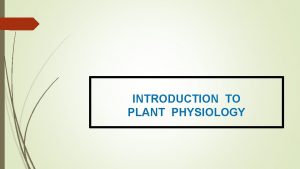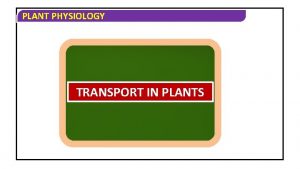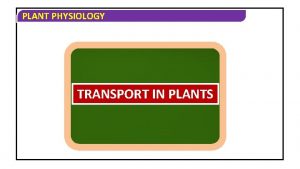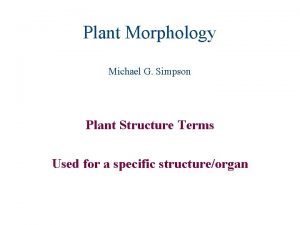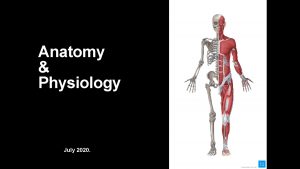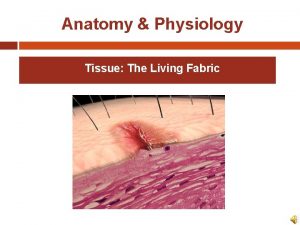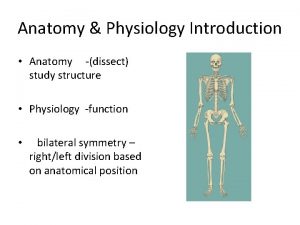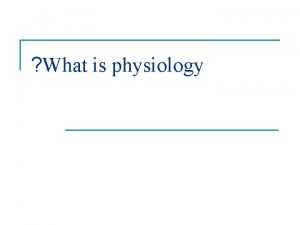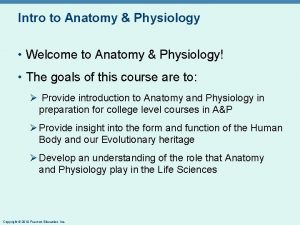Chapter 10 Plant Anatomy Physiology Michael G Simpson







































- Slides: 39

Chapter 10 Plant Anatomy & Physiology Michael G. Simpson Plant Anatomy Study of tissue and cell structure of plants. (In zoology, anatomy is study of internal organs; histology is study of tissues/cells. ) Plant Physiology Study of metabolic processes in plants.

Cell Theory All of life is composed of 1 or more cells. Cells arise only from pre-existing cells, via cell division or cell fusion. Cells are units of metabolic processes. Each cell contains set of hereditary information (DNA), transferred from cell to cell, coding for structural & functional features.

transport & modification storage high energy carbs. contains DNA structural support respiration cell recognition, transport photosynthesis protein synthesis & transport of materials ribosomes: site of protein synthesis storage: pigments, acids, ergastic substances

Ergastic Substances: not actively metabolized (storage/waste) aleurone grains: protein chromoplasts druses oil bodies amyloplasts (starch grains): alpha-1, 4 -glucopyranoside raphides crystals (Ca-oxalate; silica) styloids prismatics

cell wall mainly cellulose: beta-1, 4 -glucopyranoside

lignin - secondary cell wall function?


meristem - region of actively dividing cells 1) apical (shoot & root); 2) lateral (vascular & cork cambia) Cell differentiation: 1) Cell expansion (elongation) 2) Cell maturation / specialization

Plant Tissues & Cell Types Tissue: = group of cells with common function or structure. Three broad tissue types: 1) Dermal - outside layer(s) 2) Vascular - conduction 3) Ground - between dermal and vascular Simple vs. Complex Tissue: 1 versus 2 or more cell types

Ground Tissue Parenchyma: Gen. metabol. 1) Isodiametric to elongate 2) Primary cell wall 3) Living Collenchyma: support 1) Elongate 2) Primary cell wall thick, uneven, rich in pectins 3) Living

Ground Tissue Sclerenchyma 1) Secondary cell wall (+ primary) 2) Dead at maturity (usually) Fibers Elongate, sharply tapering

Ground Tissue Sclerenchyma 1) Secondary cell wall (+ primary) 2) Dead at maturity (usually) Sclereids Isodiametric to irregular

Vascular Tissue Xylem Water & mineral conduction Tracheary elements + parenchyma + sclerenchyma Phloem Sugar conduction Sieve members + parenchyma + sclerenchyma - Both complex tissues

Tracheary Elements Tracheids - Imperforate Vessels - Perforate Angiosperms (most) Gnetales A few Monilophytes

Sieve Elements Sieve cells - No sieve plates Sieve tube members - Sieve plates Apomorphy of Angiosperms

Dermal & Secretory tissues & cells Epidermis Glands Stomates Nectaries Laticifers

Dermal tissues: Trichome anatomy Epidermis


root cap ROOT (l. s. ) 1) Protective root cap 2) Absorptive root hairs root apical meristem

ROOT (c. s. ) 3) Give rise to new roots endogenously (from within)

Casparian Strip Function: forces fluids from outside through plasma membrane = selective absorption


SPOROPHYTIC SHOOT

Stems: • Give rise to leaves exogenously • Do not have a protective “cap” of cells • Do not have root hairs (but may have trichomes)

Stelar types eustele atactostele

Protoxylem maturation

Vascular cambium - a lateral meristem



Conifers: non-porous

Ring porous Diffuse porous

Wood Ray Anatomy

Leaf anatomy

Stomata

C 3 Photosynthesis

Kranz anatomy

C 4 Photosynthesis

CAM photosynthesis

 Simpson's index vs simpson's diversity index
Simpson's index vs simpson's diversity index Chapter 14 anatomy and physiology
Chapter 14 anatomy and physiology Chapter 1 introduction to human anatomy and physiology
Chapter 1 introduction to human anatomy and physiology Anatomy and physiology chapter 8 special senses
Anatomy and physiology chapter 8 special senses Chapter 13 anatomy and physiology of pregnancy
Chapter 13 anatomy and physiology of pregnancy Chapter 2 basic chemistry anatomy and physiology
Chapter 2 basic chemistry anatomy and physiology Chapter 7 anatomy and physiology
Chapter 7 anatomy and physiology Anatomy and physiology coloring workbook figure 14-1
Anatomy and physiology coloring workbook figure 14-1 Chapter 10 blood anatomy and physiology
Chapter 10 blood anatomy and physiology Anatomy and physiology chapter 15
Anatomy and physiology chapter 15 Anatomy and physiology chapter 1
Anatomy and physiology chapter 1 Holes anatomy and physiology chapter 1
Holes anatomy and physiology chapter 1 Anatomy and physiology chapter 15
Anatomy and physiology chapter 15 Anterior posterior distal proximal
Anterior posterior distal proximal Chapter 2 human reproductive anatomy and physiology
Chapter 2 human reproductive anatomy and physiology Male vs female skeleton pelvis
Male vs female skeleton pelvis Chapter 6 general anatomy and physiology
Chapter 6 general anatomy and physiology Cephalic cranial
Cephalic cranial Laynx
Laynx Tattoo anatomy and physiology
Tattoo anatomy and physiology Anatomy science olympiad
Anatomy science olympiad Incomplete flower
Incomplete flower Anatomy and physiology of bone
Anatomy and physiology of bone Ulcer anatomy
Ulcer anatomy Liver anatomy
Liver anatomy Podbřišek
Podbřišek Difference between anatomy and physiology
Difference between anatomy and physiology Straw colored fluid
Straw colored fluid Endomysium
Endomysium Http://anatomy and physiology
Http://anatomy and physiology Physiology of appendix
Physiology of appendix Aohs foundations of anatomy and physiology 1
Aohs foundations of anatomy and physiology 1 Aohs foundations of anatomy and physiology 1
Aohs foundations of anatomy and physiology 1 Anatomical planes
Anatomical planes Agriscience unit 26 self evaluation answers
Agriscience unit 26 self evaluation answers Science olympiad forensics cheat sheet
Science olympiad forensics cheat sheet Liver anatomy and physiology ppt
Liver anatomy and physiology ppt Pancreas anatomy and physiology
Pancreas anatomy and physiology Aohs foundations of anatomy and physiology 1
Aohs foundations of anatomy and physiology 1 Aohs foundations of anatomy and physiology 1
Aohs foundations of anatomy and physiology 1








































